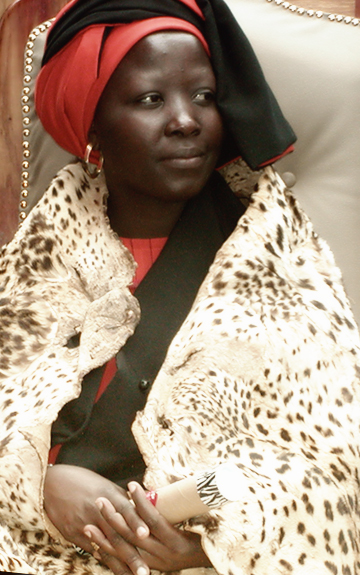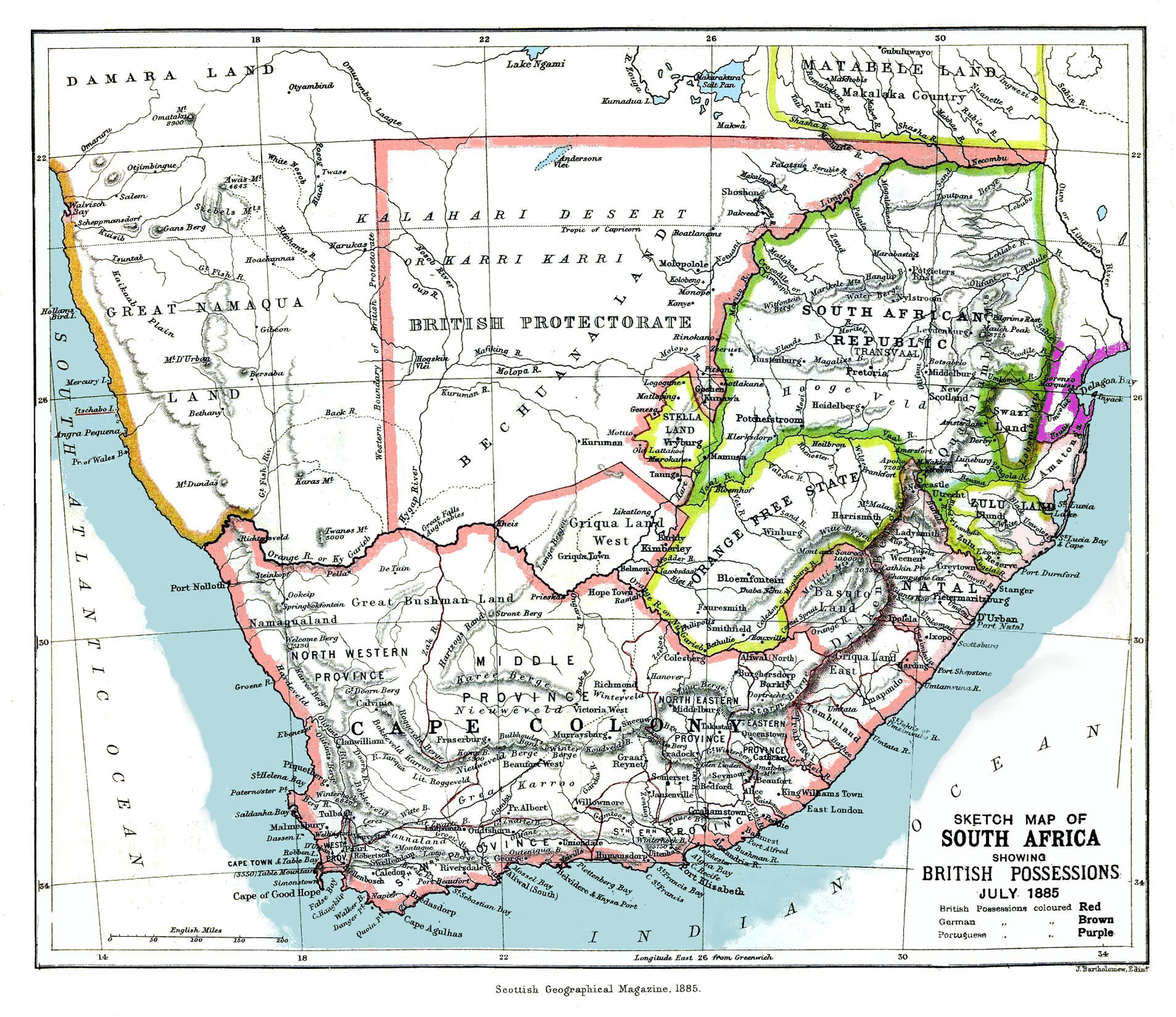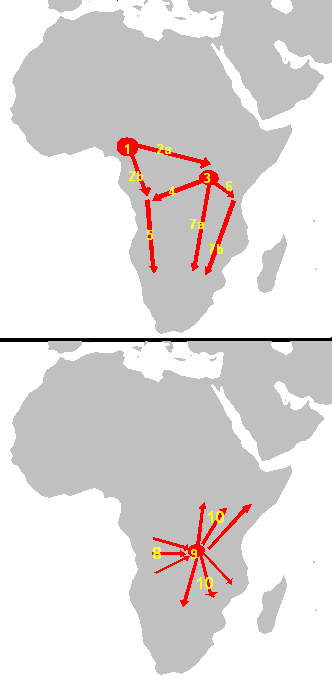|
Sotho–Tswana
The Sotho-Tswana people are a meta-ethnicity of southern Africa and live predominantly in Botswana, South Africa and Lesotho. The group mainly consists of four clusters; Southern Sotho (Sotho), Northern Sotho (which consists of the Bapedi, the Balobedu and others), Lozi, and Tswana people. A fifth cluster is sometimes referred to as the Eastern Sotho, and consists of the Pulana, Makgolokwe/Bakholokoe the Pai and others. The Sotho-Tswana people would have diversified into their current arrangement during the course of the 2nd millennium, but they retain a number of linguistic and cultural characteristics that distinguish them from other Bantu-speakers of southern Africa. These are features such as totemism, a pre-emptive right of men to marry their maternal cousins, and an architectural style characterized by a round hut with a conical thatch roof supported by wooden pillars on the outside. Other major distinguishing features included their dress of skin cloaks and a pref ... [...More Info...] [...Related Items...] OR: [Wikipedia] [Google] [Baidu] |
Sotho Language
Sotho () or Sesotho () or Southern Sotho is a Southern Bantu language of the Sotho–Tswana ("S.30") group, spoken primarily by the Basotho in Lesotho, where it is the national and official language; South Africa (particularly the Free State), where it is one of the 11 official languages; and in Zimbabwe where it is one of 16 official languages. Like all Bantu languages, Sesotho is an agglutinative language, which uses numerous affixes and derivational and inflexional rules to build complete words. Classification Sotho is a Southern Bantu language, belonging to the Niger–Congo language family within the Sotho-Tswana branch of Zone S (S.30). Although Southern Sotho shares the name ''Sotho'' with Northern Sotho, the two groups have less in common with each other than they have with Setswana. "Sotho" is also the name given to the entire Sotho-Tswana group, in which case Sesotho proper is called "Southern Sotho". Within the Sotho-Tswana group, Southern Sotho is most ... [...More Info...] [...Related Items...] OR: [Wikipedia] [Google] [Baidu] |
Sotho–Tswana Languages
Sotho–Tswana languages are a group of closely related Bantu languages spoken in Southern Africa. The Sotho–Tswana group corresponds to the S.30 label in Guthrie's 1967–71 classification of languages in the Bantu family. The various dialects of Tswana, Southern Sotho and Northern Sotho are highly mutually intelligible. On more than one occasion, proposals have been put forward to create a unified standardisation and declare a Sotho–Tswana language. Languages The group is divided into three main branches, Tswana, Northern Sotho, and Southern Sotho as follows: *Tswanaic **Tswana (''Setswana''), with dialects: Fokeng, Hurutshe, Kgatla, Kwena, Lete, Ngwaketse, Ngwato, Rolong, Tawana, Tlhaping, Tlharo, Tlokwa ** Kgalagadi, with dialects: Nuclear Kgalagadi (Kgalagadi proper), Balaongwe, Kenyi, Khakhae, Koma, Ngologa, Pedi, Phaleng, Rhiti, Shaga, Siwane *Southern Sotho **Sesotho-Lozi ***Southern Sotho or Sotho (''Sesotho''): Phuthi, Taung *Northern Sotho (''Sesotho sa Lebo ... [...More Info...] [...Related Items...] OR: [Wikipedia] [Google] [Baidu] |
Sotho People
The Sotho () people, also known as the Basuto or Basotho (), are a Bantu nation native to southern Africa. They split into different ethnic groups over time, due to regional conflicts and colonialism, which resulted in the modern Basotho, who have inhabited the region of Lesotho, South Africa since around the fifth century CE. The modern Basotho identity emerged from the accomplished diplomacy of Moshoeshoe I, who unified the disparate clans of Sotho–Tswana origin that had dispersed across southern Africa in the early 19th century. Most Basotho today live in Lesotho or South Africa, as the area of the Orange Free State was originally part of Moshoeshoe's nation (now Lesotho). History Early history Bantu-speaking peoples had settled in what is now South Africa by about 500 CE. Separation from the Tswana is assumed to have taken place by the 14th century. The first historical references to the Basotho date to the 19th century. By that time, a series of Basotho kingdoms cov ... [...More Info...] [...Related Items...] OR: [Wikipedia] [Google] [Baidu] |
Northern Sotho Language
Northern Sotho, or as an endonym, is a Sotho-Tswana language spoken in the northeastern provinces of South Africa. It is sometimes referred to as or , its main dialect, through synecdoche. According to the South African National Census of 2011, it is the first language of over 4.6 million (9.1%) people, making it the 5th most spoken language in South Africa. The Sepedi language is spoken most commonly in Mpumalanga, Gauteng and the Limpopo provinces. Name The Northern Sotho written language was based largely on the Sepedi dialect. Missionaries studied this dialect the most closely and first developed the orthography in 1860 by Alexander Merensky, Grutzner and Gerlachshoop. This subsequently provided a common writing system for 20 or more varieties of the Sotho-Tswana languages spoken in the former Transvaal, and also helped lead to "Sepedi" being used as the umbrella term for the entire language family. However, there are objections to this synecdoche by other Norther ... [...More Info...] [...Related Items...] OR: [Wikipedia] [Google] [Baidu] |
Tswana People
The Tswana ( tn, Batswana, singular ''Motswana'') are a Bantu-speaking ethnic group native to Southern Africa. The Tswana language is a principal member of the Sotho-Tswana language group. Ethnic Tswana made up approximately 85% of the population of Botswana in 2011. Batswana are the native people of south and eastern Botswana, and the Gauteng, North West, Northern Cape and Free State provinces of South Africa, where the majority of Batswana are located. History Early history of Batswana The Batswana are descended mainly from Bantu-speaking tribes along with the Khoi-San. Tswana tribe migrated southward to Africa around 600 CE, living in tribal enclaves as farmers and herders. Several Iron Age cultures flourished around the 900 CE, including the Toutswemogala Hill Iron Age settlement. The Toutswe were in the eastern region of what is now Botswana, relying on Tswana cattle breed held in kraals as their source of wealth. The arrival of the ancestors of the Tswana-speaker ... [...More Info...] [...Related Items...] OR: [Wikipedia] [Google] [Baidu] |
Lozi People
Lozi people, or Barotse, are a southern African ethnic group who speak Lozi or Silozi, a Sotho–Tswana language. The Lozi people consist of more than 46 different ethnic groups and are primarily situated between Namibia, Angola, Botswana, Zimbabwe including half of eastern and northern province of Zambia inhabiting the region of Barotseland. Lozi is also a nationality of the people of Barotseland, an amalgamation of several smaller ethnic groups and tribes. The Lozi people number approximately 5,575,000. Lozi are also found in Zambia, Namibia (Caprivi Strip), Angola, Botswana, Mozambique (50,000), and Zimbabwe (8,000). The Lozi are also known as the Malozi, Nyambe, Makololo, Barotose, Rotse, Rozi, Rutse, Baloyi, Balobedu or Tozvi. Name The word Lozi means 'plain' in the Makololo language, in reference to the Barotse Floodplain of the Zambezi on and around which most Lozi live. It may also be spelled Lotse or Rotse, the spelling Lozi having originated with German missionaries in ... [...More Info...] [...Related Items...] OR: [Wikipedia] [Google] [Baidu] |
Bantu Peoples
The Bantu peoples, or Bantu, are an ethnolinguistic grouping of approximately 400 distinct ethnic groups who speak Bantu languages. They are native to 24 countries spread over a vast area from Central Africa to Southeast Africa and into Southern Africa. There are several hundred Bantu languages. Depending on the definition of "language" or "dialect", it is estimated that there are between 440 and 680 distinct languages. The total number of speakers is in the hundreds of millions, ranging at roughly 350 million in the mid-2010s (roughly 30% of the population of Africa, or roughly 5% of the total world population). About 60 million speakers (2015), divided into some 200 ethnic or tribal groups, are found in the Democratic Republic of the Congo alone. The larger of the individual Bantu groups have populations of several million, e.g. the people of Rwanda and Burundi (25 million), the Bagandapeople of Uganda (10 million as of 2019), the Shona of Zimbabwe (15 million ), the Zulu of ... [...More Info...] [...Related Items...] OR: [Wikipedia] [Google] [Baidu] |
MaPulana
The Pulana or Mapulana, are a low-veld Sotho-Tswana ethnic group found in the northeastern part of the Mpumalanga and southeastern Limpopo provinces. Their language is called Sepulana (SeKutswe and Pai) and is considered dialect of the Northern Sotho language group. The area where the Pulana live is called Mapulaneng, it stretches from Crocodile River in the south to the Swazi border (Mapulana of Mashego ) from Crocodile to Olifants River (Limpopo) in the north, Lebombo Mountains in the east and also includes the whole town of Hazyview, White River, Mpumalanga ( Lepunama), Sabie, Graskop, Hoedspruit, Barberton, Lydenburg and Dullstroom in the west. In the Pulana language or Sepulana, Mapulaneng means "Place of the Mapulana people"; the tribe derive their name from their founding leader, Lepulana who later changed his name to Chiloane. Mapulana are descendants of Morolong and their origin can be traced back to the Kgalagadi before they settled in Thaba Chueu, in what is today eas ... [...More Info...] [...Related Items...] OR: [Wikipedia] [Google] [Baidu] |
Lobedu People
The Lobedu or Balobedu ''(''also known as the BaLozwi or Bathobolo'')'' are a southern African ethnic group. Their area is called Bolobedu. They are initially known as Bakwebo (wild pigs). The name "balobedu" means "the mineral miners" lobela / go loba - to mine , their ancestors are part of the great Mapungbuwe early civilization. They have their own kingdom, the Balobedu Kingdom, within the Limpopo Province of South Africa with a female ruler, the Rain Queen Modjadji. It is estimated that there is around 1 million BaLobedu in South Africa . Their population is found in Greater Letaba Local Municipality (171 011 or 80.4% - 2011 census), Greater Tzaneen Local Municipality (200 000 or 46% - 2011 census), Ba-Phalaborwa Local Municipality (70 000 or 47% - 2011 census), Greater Giyani Local Municipality (20 000 or 6.4% - 2011 census) and smaller villages of Limpopo. Some are found in Gauteng province as labour migrants, especially in Tembisa and Alexandra townships. Language ... [...More Info...] [...Related Items...] OR: [Wikipedia] [Google] [Baidu] |
Pedi People
The Pedi or (also known as the Northern Sotho or and the Marota or ) – are a Southern Africa, southern African ethnic group that speak Pedi or ''Sepedi'', a dialect belonging to the Sotho-Tswana peoples, Sotho-Tswana Ethnolinguistic group, enthnolinguistic group. Northern Sotho is a term used to refer to one of South Africa's 11 official languages. Northern Sotho or Sesotho sa Leboa consist of 33 dialects, of which Pedi is one of them. The BaPedi people are almost exclusively found in South Africa's Points of the compass, northeastern Provinces of South Africa, provinces which are Limpopo, and parts of northern Mpumalanga. There is confusion regarding the distinction between BaPedi people, and tribes referred to Northern Sotho (''Basotho ba Lebowa).'' On the one hand, one military explanation is that the BaPedi people became powerful at one point under a powerful king that ruled over a large piece of land. During this period, a powerful army of the BaPedi conquered small ... [...More Info...] [...Related Items...] OR: [Wikipedia] [Google] [Baidu] |
South Africa Dominant Language Map
South is one of the cardinal directions or compass points. The direction is the opposite of north and is perpendicular to both east and west. Etymology The word ''south'' comes from Old English ''sūþ'', from earlier Proto-Germanic ''*sunþaz'' ("south"), possibly related to the same Proto-Indo-European root that the word ''sun'' derived from. Some languages describe south in the same way, from the fact that it is the direction of the sun at noon (in the Northern Hemisphere), like Latin meridies 'noon, south' (from medius 'middle' + dies 'day', cf English meridional), while others describe south as the right-hand side of the rising sun, like Biblical Hebrew תֵּימָן teiman 'south' from יָמִין yamin 'right', Aramaic תַּימנַא taymna from יָמִין yamin 'right' and Syriac ܬܰܝܡܢܳܐ taymna from ܝܰܡܝܺܢܳܐ yamina (hence the name of Yemen, the land to the south/right of the Levant). Navigation By convention, the ''bottom or down-facing sid ... [...More Info...] [...Related Items...] OR: [Wikipedia] [Google] [Baidu] |
Bantu Expansion
The Bantu expansion is a hypothesis about the history of the major series of migrations of the original Proto-Bantu-speaking group, which spread from an original nucleus around Central Africa across much of sub-Saharan Africa. In the process, the Proto-Bantu-speaking settlers displaced or absorbed pre-existing hunter-gatherer and pastoralist groups that they encountered. The primary evidence for this expansion is linguistic – a great many of the languages which are spoken across Sub-Equatorial Africa are remarkably similar to each other, suggesting the common cultural origin of their original speakers. The linguistic core of the Bantu languages, which comprise a branch of the Atlantic-Congo language family, was located in the southern regions of Cameroon. However, attempts to trace the exact route of the expansion, to correlate it with archaeological evidence and genetic evidence, have not been conclusive; thus although the expansion is widely accepted as having taken place, ... [...More Info...] [...Related Items...] OR: [Wikipedia] [Google] [Baidu] |


_(14796270283).jpg)



